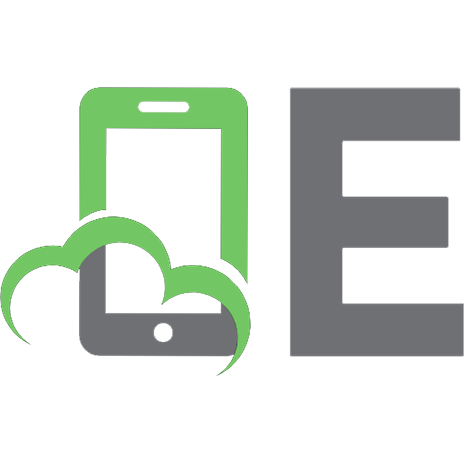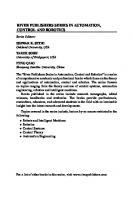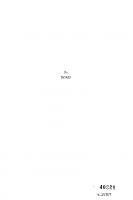The Dynamics of Automatic Control Systems 1483168816, 9781483168814
380 74 19MB
English Pages 776 [753] Year 2014
Recommend Papers
File loading please wait...
Citation preview
E . P. P O P OV
THE DYNAM ICS OF AUTOM ATIC CONTROL SYSTEM S
THE DYNAMICS OF AUTOMATIC CONTROL SYSTEMS
by E. P. POPOV
Translated from the Russian
PERGAMON PRESS O XFO RD • LO N D O N • NEW YO RK • PARIS
1962
PERGAMON PRESS LTD. Headington H ill Hall, Oxford 4 & 5 Fitzroy Square, London W .l PERGAMON PRESS INC. 122 East 55th Street, New York 22. N. Y. 1404 New York Avenue, N .W ., Washington 5, D.C. PERGAMON PRESS S.A.R.L. 24 Bue des Ecoles, Paris Ve PERGAMON PRESS G.m.b.H. Kaiserstrasse 75, Frankfurt am Main
Copyright 1961 Pergamon Press Ltd.
Library of Congress Card No. 60-16485
Printed in Poland to the order of Pahstwowe Wydawnietwo Na/ukowe hy Drukamia Uniwersytetu Jagiellonskiego, Erakdw
ENGLISH EDITOR'S INTRODUCTION Peofessoe P opov’s book on the theory of servomechanisms and control systems will be of interest to English readers in showing the meticulous detail into which Russian engineers and students are led when discussing these subjects. A few standard and useful examples are taken and form the basis for discussion at all levels, from the most elementary to the most complete and advanced, so th a t a sense of continuity is preserved throughout the volume. The translation preserves much of the Russian sentence structure and the editor did not find it possible to alter this without a more or less complete rewriting of the translator’s manuscript. Neverthe less, it is hoped th a t a readable result has been obtained and th a t the spirit of the whole is faithful to th a t of the original. A. D. B.
FOREWORD The w ide study of the theory of automatic control in our insti tutions of higher education is a very recent development. Many engineers therefore have come to study it only when already engaged in practical work. The present book has the aim of assisting these broad circles of engineers and students to acquaint themselves in the most accessible form with the foundations of the theory of automatic control, in which the main role is played by the dynam ics of control systems. Following the aim of the most accessible development, the author has consciously tried to reduce to a minimum the use of operational calculus and the theory of functions of the complex variable and everywhere, where possible, to confine himself to the use of the symbolic operational method as a means of simplifying the notation and manipulation of differential equations. The book presents those theoretical methods of analysis and synthesis of automatic control systems common to systems of various physical natures and designs. The concrete examples presented in the book, therefore, by no means pretend to reproduce the designs of contemporary automatic control systems. They will be only the simplest functional circuits serving to illustrate the principal ideas in the construction of automatic control systems and the application of the theoretical methods developed here. By analogy, the reader may then apply these ideaB and methods to the concrete automatic control systems of interest to him. Attempting to describe in detail the fundamental results of the theory of automatic control, the author has been forced to limit himself to brief remarks on a number of special questions. Statistical methods and questions of representation of automatic control systems have been completely neglected here. Each of these important fields is so specialised th a t it may constitute the subject of separate books. The author expresses his appreciation to Comrades T a. Z. Tsypkin, O. K. Sobolev and I. V. Korol’kov for valuable remarks when re viewing the manuscript.
CHAPTER I
FORMS OF AUTOMATIC CONTROL SYSTEMS 1. The concept of closed automatic systems
There exist very many forms of automatic systems performing various functions in the control of the most varied physical pro cesses in all branches of engineering. These systems consist of mechanical, electrical and other devices of widely different designs, assembled in an overall complex of mutually interacting circuits. As examples of automatic Bystems we may list: (a) automatic light switches including a photocell which reacts to the intensity of daylight and a special device for turning on the light, operating on a definite signal from this photocell; (b) a machine for vending given objects (e.g. tickets, chocolates) when a given combination of coins is fed into it; (c) automatic machines, automatic production lines and automatic factory departments; (d) remote-control systems in which a defined combination of heavy or complicated operations in the controlled object are carried out upon depression of a button or an easy rotation of a handle on the control panel; (e) automatic regulation of motor speed, maintaining' constant angular velocity of the motor independently of the external load (analogously, temperature, pressure, voltage and frequency regu lators, etc.); (f) automatic pilots, maintaining a definite course and altitude of an aircraft without intervention by the pilot; (g) servomechanisms in which an arbitrary variation in time of some quantity applied to the input is exactly copied at the output to a defined precision; (h) a tracking system, in which the barrel of an anti-aircraft gun is automatically trained on a flying aircraft; (i) a computer carrying out a defined mathematical operation (differentiation, integration, the solution of equations, etc.); (j) measuring devices operating on the compensation principle; (k) synchronous remote transm itters, etc. 3
4
The Dynamics of Automatic Control Systems
All these and similar automatic systems may be divided into two main classes: (1 ) automatic machines carrying out definite types of single or repeated operations; among these are, for example, lighting switches, ticket vendors, automatic machines, machine guns, velocity switching mechanisms, etc.; (2 ) automatic systems which over a fairly long period of time vary some physical quantity in a necessary manner (or maintain it constant) (the coordinates of a moving object, velocity, voltage, frequency, temperature, pressure, acoustic level, etc.) in some con trolled process. Among these are automatic controls, servo mechanisms, automatic pilots, certain computing devices, certain measuring equipment, remote control systems, etc. In the present book we shall consider only automatic systems of the second class. These are divided into open and closed loop automatic systems. The general structural circuit of an open loop system is shown in two forms (a and b) in Fig. 1. This is the simplest control system: semi-automatic when the source of commands is the human being,
F ig . 1
and automatic if the source of commands is the variation of certain external conditions in which the given system operates (temperature or pressure of the surrounding medium, electric current, illumina tion, range of frequency, etc.). The second structural circuit shown in Fig. 1 differs from the first in th a t besides control organs there are also measurement devices which permit the course of the process in the controlled object to be observed. A characteristic of open loop systems is th at the functioning of the system is not directly dependent on the result of its action. A natural further improvement of automatic systems is the con nection of the output (measuring instruments) back to the input (source of commands) so th a t the measuring instruments, measuring a certain quantity characterising a definite process in the control object should themselves be simultaneously a source of action on the system, where the magnitude of this action will depend on the
Forms of Automatic Control Systeins
5
magnitude by which the measured quantities in the controlled object deviate from their required values. Closed loop automatic systems thus arise. It is easy to conceive th at in the closed loop automatic system there is a complete inter action of operation of all circuits with each other. The courses of all processes in a closed loop system are radically different from processes in open loop systems. The closed loop system reacts com pletely differently to external perturbing forces. Various valuable properties of closed loop automatic systems make them irreplaceable in all cases where precise and high-speed automatic systems are required for control, measurement or for carrying out mathematical calculations. Dynamic calculations take on special importance in the design of any closed loop automatic system. Closed loop automatic systems exist in engineering in the form of automatic regulators, servomechanisms, computers, compen sation-type measuring systems, automatic pilots, stabilisation systems, remote control systems, etc. All these forms of closed loop automatic systems may be reduced to the single general circuit represented in Fig. 2. If this represents Measureaent
of
control
Control
action
effect
action
F ig . 2
a servomechanism the external driving force y(t) may be arbitrary in time and it is required that the controlled object should repeat as exactly as possible this arbitrarily-given time variation in the form of a mechanical motion or displacement or in the form of variation of an arbitrary electrical or other physical quantity. At the same time it should be possible to eliminate as far as possible interference of all external perturbing forces f(t) on the controlled object (and possibly on the control system itself). If it represents an automatic regulation system the role of the control system (Fig. 2) is played by a regulator, the role of the external driving force y(t) by the setting of the regulator or programme control. In this case it is always assumed th at substantial external perturbing forces /(0. Therefore, in passage to the limit in (6.15) there is obtained an instantaneous impulse (zero duration with infinite value /), but the magnitude of the impulse (area) is equal to unity. From this there follows in particular th at +oo +00 h (6.17) j 1 '{t)dt = lim f f(t,h )dt = lim ( \dt = 1 , x J0 h-+0 J0 ™ 0 where it is obvious th at /
!'(*)« = 0 .
44
The Dynamics of Automatic Control Systems
The integral of the unit impulse l'(t) is consequently a unit step 1(f) and signifies th a t the unit impulse which we denote by l'(f) is the time derivative of the unit step 1 (f). An external force having the form of an instantaneous non-unit step of arbitrary magnitude f° and y° may be written in the form / = /« l( f )
and
y = y°-l(t)
(6.18)
and the instantaneous impulse f = fi-l'(t)
(6.19)
or, with regard to Fig. 38a A step of the form of Fig. 35a may be written analogously in the form f = f ° + ( f ° - n •!(-0 ), we obtain the moments of time t = —0 and t = + 0 for the start and finish respectively of the step (or impulse or application of arbitrary force). They actually correspond to two different states of the system, which are very close to each other in time, but may differ from each other by relatively large differ ences in the magnitudes of the coordinates, velocities and other variable quantities. Thus, for example, it is familiar from mechanics th a t application of an “instantaneous” impulse (shock) to a mass causes “instantaneous” change in its velocity by a definite finite quantity. The term “ instantaneous” is understood in the sense of “during the time: —e < t < + e ” or, according to the above con vention, from t = —0 to t = + 0 (as e->-0 ). From this it follows th at in all cases where for t = 0 there occurs a step, impulse or instantaneous application of arbitrary force, it is necessary clearly to distinguish what is actually meant by the initial conditions of the process: the state of the system at the instant t = —0 (directly before the step) or the instant t = + 0 (immediately after the step). Both of these have their significance. In the former, the step itself is included in the process considered by us, while in the latter the process in the system after the step has already occurred is considered. The initial conditions written for t = —0 correspond to the state of the system before the step. For example, for the processes shown in Figs. 35, 36, 37, 38 and 39, we have x = aP°, x = x = ... = x(n-v = 0 at t = —0 . The initial conditions written for t = -f0: x = x0, x = £„, x = #0, ..., x(n~l) = Xon~1}
at
t= +0,
express the instantaneous change of the corresponding quantities, occuring during the step. Therefore, in Figs. 35-39, where x = 0 at t = —0 , in general, we may obtain x0 ^ 0 at t = + 0 , i.e. there may occur a break in the curve a t the point t = 0 . From the above there follows the necessity of having formulae for transforming the given initial conditions for t = —0 , expressing the state of the system before the jump, to the initial conditions
The Dynamics of Automatic Control Systems
46
for t = + 0 , defining the initial data of the required course of the process immediately after the step. The derivation of these formulae is easily carried out using opera tional calculus which gives: 1 ) the application of the step itself and the state of the process under consideration employing the initial conditions for t = —0 ; 2 ) consideration of the process after the jump with initial conditions for t = + 0. By comparison of these two forms the initial conditions for t = + 0 are defined through the conditions for t = —0. This will be proved in Section 74 (p. 737). Here we give only the final formulae for calculating the initial con ditions. The value of x and its derivatives for t = —0 (before the jump) will be given the index —0 , while for t = + 0 (after the jump), the index + 0 . When a unit step of the variable / acts (Fig. 41a) we have the following formulae for transforming the initial conditions: (n—m—1) (n—m—1) -- *4'—0 J 3/+0 — 0, 3C-M> = i _ 0, .... , it/-1-0 (n—m) ■t'-i-o —a —o a0 (n-m+l) (»—m+1 - h . i . .*/-(-0 ‘*'—0 «o (n-m+2) (n-m +2) - ^ { x % m)- x 2{ om)) ■*'+0 •*'—0 d0 *0 ——(x+^m+1) —a?(”Q „(»-*) '^ + 0
—
(»-l) _ bm- 1 — -------------(Iq
^ - 0
am- 1/ (n-m) •i - -------------------------- V & + 0
(n-m)v —
•*'— 0
) —
••• —
#0
where m and n are the degrees of the operational polynomials in the differential equation of the given system (5.6), m < w; a0, a^, ..., b0, blf ... are the coefficients of these equations defined by the parameters of the system. In these formulae the operator 1 has the dimensions of the quantity f. If the force is applied in the form of a step, not equal to unity, in place of 1 the magnitude of the step should be substituted. With a force in the form of a unit step of the variable y we obtain from (6.23) formulae for transformation of the initial conditions by substitution of the quantity m by v and the quantities b0,b lf ... by c0, e1, ... from the differential equation (5.6) of the system. From formulae (6.23) it is evident th at for equality of the degrees of the operational polynomials in the right and left sides of the
Transients in Automatic Regulation Systems
47
differential equations of this system (m = n or v = n) the step at the point t = 0 will occur not only for the derivatives in x but also for x itself, namely, x+0—x -0 — b0[a0-1 . Formulae (6.23) also show th a t if m = 0,i.e. if the operational polynomial forf(t) isabsent and the equation of the system has the form L(p )x = b0f(t) , (6.24) for a step of the variable /, the initial conditions for t = + 0 are equal to the initial conditions for t = —0. The same occurs for a step of the variable y in the equation L{p)x = c0y(t) .
(6.25)
If in the equation of the system for /(


![Aircraft Dynamics and Automatic Control [Course Book ed.]
9781400855988](https://ebin.pub/img/200x200/aircraft-dynamics-and-automatic-control-course-booknbsped-9781400855988.jpg)


![Automatic Control Systems [10 ed.]
1259643832, 9781259643835](https://ebin.pub/img/200x200/automatic-control-systems-10nbsped-1259643832-9781259643835.jpg)




